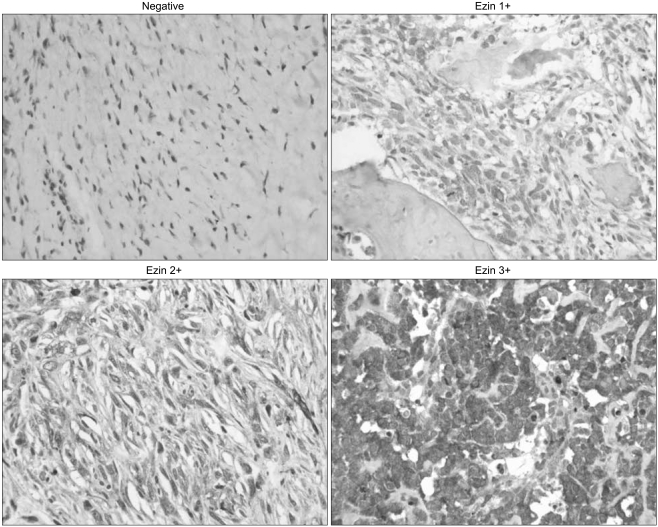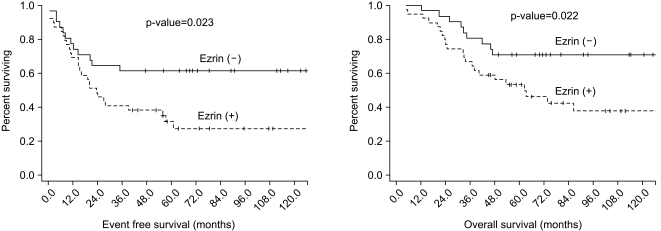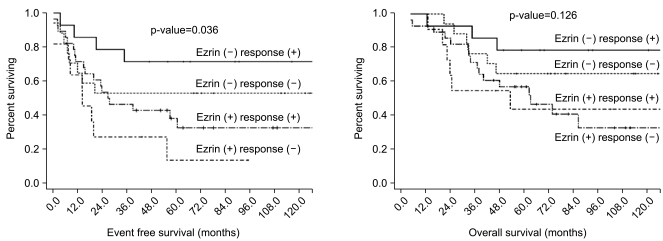Cancer Res Treat.
2009 Sep;41(3):138-144.
Clinical Value of Ezrin Expression in Primary Osteosarcoma
- Affiliations
-
- 1Yonsei Cancer Center, Yonsei University College of Medicine, Seoul, Korea. rha7655@yuhs.ac
- 2Department of Internal Medicine, Yonsei University College of Medicine, Seoul, Korea.
- 3Department of Pathology, Inje University College of Medicine, Sanggyepaik Hospital, Seoul, Korea.
- 4Department of Pathology, Yonsei University College of Medicine, Seoul, Korea.
- 5Brain Korea 21 Project for Medical Science, Yonsei University College of Medicine, Seoul, Korea.
Abstract
- PURPOSE
Ezrin is a membrane cytoskeletal linker protein and it is known to be associated with metastasis of primary osteosarcoma. The aim of this study is to determine the relationship between an ezrin expression and several key clinical parameters and to elucidate its potential prognostic value for patients with osteosarcoma. MATERIALS AND METHODS: Seventy patients with histologically confirmed osteosarcoma and who had no distant metastasis were enrolled between 1995 and 2005 at Yonsei Cancer Center, Severance Hospital, Korea. The clinical parameters were retrospectively reviewed and immunohistochemical staining (IHC) for ezrin was performed using the surgically resected specimens. RESULTS: Of the 70 tumor specimens, 39 (55.7%) revealed an ezrin expression. More of an osteoblastic histology and an elevated initial ALP level were observed in the ezrin positive patients than in the ezrin negative patients (p=0.008 and 0.001, respectively). The proportion of patients who favorably responded to neoadjuvant chemotherapy (> or =90% necrosis) was significantly higher in the group of ezrin positive patients than that in the group of ezrin negative patient (72.2% vs 45.2%, respectively, p=0.024). The ezrin positive patients showed more frequent recurrence than did the ezrin negative patients (64.1% vs 35.5%, respectively, p=0.017). The patients with an ezrin expression also demonstrated poorer survival than did those patients without ezrin expression (5-year EFS: 31.7% vs 61.3%, respectively, p=0.023, 5-year OS: 53.4% vs 71.0%, respectively, p=0.022). When comparing EFS according to both an ezrin expression and chemoresponsiveness, there were trends that the ezrin negative/chemoresponsive group showed the best 5-year EFS (71.4%), followed by the ezrin negative/chemoresistant group (52.9%), the ezrin positive/chemoresponsive group (38.1%) and the ezrin positive/chemoresistant group (13.6%). These trends were statistically significant (p=0.036). CONCLUSION: The expression of ezrin by IHC staining was found in 55.7% of the patients with metastasis-free osteosarcoma. Immunoreactivity to ezrin is a negative prognostic factor for survival for the patients suffering with osteosarcoma. Identifying an ezrin expression might offer a valuable piece of information when treating patients with primary osteosarcoma.
Keyword
MeSH Terms
Figure
Reference
-
1. Meyers PA, Heller G, Healey J, Huvos A, Lane J, Marcove R, et al. Chemotherapy for nonmetastatic osteogenic sarcoma: the memorial sloan-kettering experience. J Clin Oncol. 1992; 10:5–15. PMID: 1370176.
Article2. Bacci G, Longhi A, Versari M, Mercuri M, Briccoli A, Picci P. Prognostic factors for osteosarcoma of the extremity treated with neoadjuvant chemotherapy: 15-year experience in 789 patients treated at a single institution. Cancer. 2006; 106:1154–1161. PMID: 16421923.3. Kalifa C, Razafindrakoto H, Vassal G, Contesso G, Vanel D, Edeline V, et al. Chemotherapy in osteogenic sarcoma: the experience of the pediatric department of the gustave roussy institute. Cancer Treat Res. 1993; 62:347–349. PMID: 7682093.
Article4. Clark JC, Dass CR, Choong PF. A review of clinical and molecular prognostic factors in osteosarcoma. J Cancer Res Clin Oncol. 2008; 134:281–297. PMID: 17965883.
Article5. Bretscher A, Edwards K, Fehon RG. ERM proteins and merlin: integrators at the cell cortex. Nat Rev Mol Cell Biol. 2002; 3:586–599. PMID: 12154370.
Article6. Hunter KW. Ezrin, a key component in tumor metastasis. Trends Mol Med. 2004; 10:201–204. PMID: 15121044.
Article7. Elliott BE, Meens JA, SenGupta SK, Louvard D, Arpin M. The membrane cytoskeletal crosslinker ezrin is required for metastasis of breast carcinoma cells. Breast Cancer Res. 2005; 7:R365–R373. PMID: 15987432.
Article8. Weng WH, Ahlen J, Astrom K, Lui WO, Larsson C. Prognostic impact of immunohistochemical expression of ezrin in highly malignant soft tissue sarcomas. Clin Cancer Res. 2005; 11:6198–6204. PMID: 16144921.
Article9. Elzagheid A, Korkeila E, Bendardaf R, Buhmeida A, Heikkila S, Vaheri A, et al. Intense cytoplasmic ezrin immunoreactivity predicts poor survival in colorectal cancer. Hum Pathol. 2008; 39:1737–1743. PMID: 18701134.
Article10. Moilanen J, Lassus H, Leminen A, Vaheri A, Butzow R, Carpen O. Ezrin immunoreactivity in relation to survival in serous ovarian carcinoma patients. Gynecol Oncol. 2003; 90:273–281. PMID: 12893187.
Article11. Khanna C, Wan X, Bose S, Cassaday R, Olomu O, Mendoza A, et al. The membrane-cytoskeleton linker ezrin is necessary for osteosarcoma metastasis. Nat Med. 2004; 10:182–186. PMID: 14704791.
Article12. Kim MS, Song WS, Cho WH, Lee SY, Jeon DG. Ezrin expression predicts survival in stage IIB osteosarcomas. Clin Orthop Relat Res. 2007; 459:229–236. PMID: 17353802.
Article13. Xu-dong S, Zan S, Shui-er Z, Li-na T, Wen-xi Y, Feng L, et al. Expression of ezrin correlates with lung metastasis in Chinese patients with osteosarcoma. Clin Invest Med. 2009; 32:E180–E188. PMID: 19331807.
Article14. Sohn JH, Rha SY, Jeung H, Shin HC, Shin HJ, Goo YS, et al. Efficacy of pre- and postoperative chemotherapy in patients with osteosarcoma of the extremities. Cancer Res Treat. 2001; 33:520–526.
Article15. Park HR, Jung WW, Bacchini P, Bertoni F, Kim YW, Park YK. Ezrin in osteosarcoma: comparison between conventional high-grade and central low-grade osteosarcoma. Pathol Res Pract. 2006; 202:509–515. PMID: 16677779.
Article16. Salas S, Bartoli C, Deville JL, Gaudart J, Fina F, Calisti A, et al. Ezrin and alpha-smooth muscle actin are immunohistochemical prognostic markers in conventional osteosarcomas. Virchows Arch. 2007; 451:999–1007. PMID: 17786474.
Article17. Makitie T, Carpen O, Vaheri A, Kivela T. Ezrin as a prognostic indicator and its relationship to tumor characteristics in uveal malignant melanoma. Invest Ophthalmol Vis Sci. 2001; 42:2442–2449. PMID: 11581181.18. Bentzen SM, Poulsen HS, Kaae S, Jensen OM, Johansen H, Mouridsen HT, et al. Prognostic factors in osteosarcomas. A regression analysis. Cancer. 1988; 62:194–202. PMID: 3164231.
Article19. Uribe-Botero G, Russell WO, Sutow WW, Martin RG. Primary osteosarcoma of bone. Clinicopathologic investigation of 243 cases, with necropsy studies in 54. Am J Clin Pathol. 1977; 67:427–435. PMID: 266360.20. Hauben EI, Weeden S, Pringle J, Van Marck EA, Hogendoorn PC. Does the histological subtype of high-grade central osteosarcoma influence the response to treatment with chemotherapy and does it affect overall survival? A study on 570 patients of two consecutive trials of the European Osteosarcoma Intergroup. Eur J Cancer. 2002; 38:1218–1225. PMID: 12044509.
Article21. Rosen G, Marcove RC, Caparros B, Nirenberg A, Kosloff C, Huvos AG. Primary osteogenic sarcoma. the rationale for preoperative chemotherapy and delayed surgery. Cancer. 1979; 43:2163–2177. PMID: 88251.
Article
- Full Text Links
- Actions
-
Cited
- CITED
-
- Close
- Share
- Similar articles
-
- Ezrin is an Essential Marker for Metastasis of Gynecologic Cancer
- ERK1/2 Activation Modulates Matrix Metalloproteinase 2 Activity and Ezrin Expression in Osteosarcoma Cell Lines
- Prognostic Significance of Ezrin Expression in Liposarcoma
- Clinicopathologic Implication of Ezrin Expression in Non-small Cell Lung Cancer
- Uterine cancer and ezrin expression




